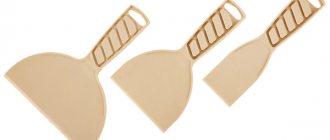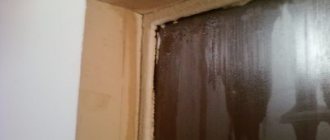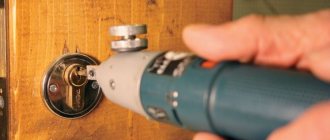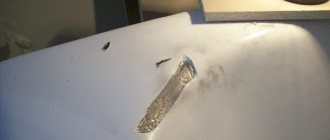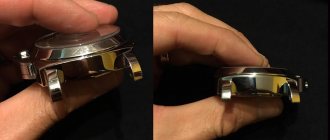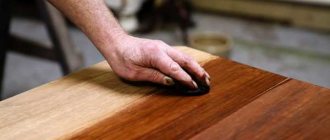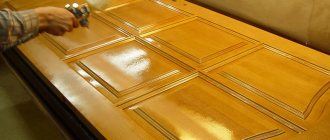How to remove scratches on a metal door
The attractive appearance of a metal door today is an important factor in deciding whether to purchase it.
At the same time, serious attention is paid not only to the aesthetic characteristics of the protective and decorative coating, but also to its reliability and durability. However, during the operation of the entrance structure, scratches often appear on the metal door. This can happen even with the most seemingly durable resistant coatings. In such a situation, the owner’s desire to remove scratches on a metal door seems quite natural. Obviously, it is extremely irrational to purchase a new entrance structure because of such a minor defect. The choice of method of performing the work depends mainly on the finishing option of the product.
Restoration of interior doors - traditional and alternative options
Conflicting attitudes towards interior items and differences in the financial capabilities of some owners lead to the purchase of a new item, while others lead to the need for restoration. Most owners prefer to store and repair exclusive and antique products ad infinitum, passing them on by inheritance. Not everyone is ready to update modern furniture or doors, although it’s worth thinking about. After all, a small chip or scratch can be easily removed, but it is simply necessary to restore objects that are still durable but have lost their appearance. They can acquire a completely different look, style and become unique.
How to remove scratches on a wood-trimmed metal door
Many steel systems are finished with natural solid wood or artificial wood panels. All of them are scratched to a greater or lesser extent, after which they require restoration. There are many ways to restore the facing layer of such a coating.
- The walnut is cracked, the edible core is removed, and its fourth part is broken off. The formed piece is rubbed into the defect until the oils fill the recess. With a small flaw, the camouflage will be excellent.
- One of the best materials to solve the problem is furniture wax. It is often sold in specialized stores and can be easily selected in the desired color. Scratches on a metal door are cleaned from dust and dirt with a rag, sealed with wax using a spatula, and after complete drying, polished until the marks disappear.
- Olive oil and table vinegar are mixed in a vessel - ratio 3:1. The damaged area is wiped off from dust and smeared with the solution several times with a brush. After 15 minutes, remove any remaining liquid with a dry cloth.
- If you have machine oil or iodine on hand, you can use one of these products - they paint over small abrasions quite effectively. You just need to moisten a cotton swab with the substance and “walk” it over the scratches several times.
The number of methods in the given options is not exhausted. It is allowed to shade the problem area with stain, provided that it matches the color scheme - the composition is applied with a brush. You can paint over the defect with steeply brewed tea - it should sit for at least 30 minutes. Furniture touch is also used for this problem - a special product that is applied in 2 or 3 layers. As a last resort, you can use a pencil, felt-tip pen or marker - of course, one that matches the color.
Folk remedies
- Vinegar and olive oil will mask minor scratches and imperfections. Mix the components in proportions of 1 to 3 and rub the resulting composition onto scratches on the door or furniture. Then wipe the surface dry with a clean cloth;
- Walnut quickly fills scratch grooves and leaves no marks. The treatment looks natural and natural. To do this, cut the nut in half, gently rub the half with light pressure on the damaged areas and wipe with a dry cloth to remove the oily residue. You can cover this area with a thin layer of wood varnish;
- Iodine will help restore dark wood. This is walnut, oak or mahogany. Take an old toothbrush or other small brush, soak it in a weak iodine solution and treat scratches on the countertop, cabinet, door or other wooden products;
- Mayonnaise eliminates cracks. Fill the grooves with the product, remove excess and leave for two to three days. Due to the protein, the tree swells and closes the cracks on its own. After this, remove the remaining mayonnaise and polish the surface;
- Mix cigarette ash or toothpaste with water until a thick mass is obtained. Rub the resulting mixture into the damaged area and leave until dry. Remove excess and polish the surface;
- Black tea also helps remove scratches. Pour 35 ml of boiling water over one tea bag. Leave the composition to brew and gain strength. Then apply tea leaves to the affected areas using a cotton pad and wait until dry;
- Homemade mastic made with your own hands. To prepare the mixture, take 40 grams of solid wax and melt it, or use ready-made liquid wax, but it also needs to be heated. Add 30 grams of turpentine and a teaspoon of alcohol to the solution, mix. The product is applied warm to the affected area and distributed over the surface, then rubbed with a napkin until shiny;
- Sandpaper will remove all damage from wooden surfaces. To do this, use fine-grained sandpaper, which is used for finishing sanding, with a number P 600 and higher. Moisten the sheet and work the surface along the wood fibers. Finally, walk around the defect to smooth out the marks and buff the piece with a cloth.
Anti-vandal coating
It happens that when buying a door, you are assured of the durability of the metal door’s coating, especially if it is coated with powder paint; many sellers and manufacturers call such a coating anti-vandal.
But, you need to keep in mind that this concept is quite relative. Yes, such doors, with anti-vandal coatings and anti-claw panels, have excellent wear resistance characteristics, but this does not mean at all that there will not be a trace of a nail left on the surface of the door if you run it well over the door, and that a cat, deciding to sharpen its claws on your door, with anti-vandal coating, will not leave claw marks. Anti-vandalism is a rather arbitrary concept; harder metal always leaves marks on softer metal, keep this in mind when purchasing a door.
Despite their external durability and strength, metal doors can be easily damaged. To prevent this from happening, you need to treat them with care and properly care for them. It is advisable to purchase special cleaning products designed for metal doors or metal surfaces. Do not use detergents with abrasive components, they can damage the top layer and even change color and speed up the aging process of the door.
You can also use a simple home remedy that is perfect for caring for metal doors: you need to take water and ethyl alcohol in a ratio of 9:1 and wash the door, and then wipe it dry.
Where are shiny sashes installed?
You can buy a polished door for any room that you want to make lighter, more elegant, more interesting. Glossy door leaves are good both as light sources and as expressive accents that enliven the space.
Similar models look great:
- in small bathrooms and kitchens. In interiors subordinated to urban style, they are combined with aluminum and glass furnishings;
- in living rooms of both classical and minimalist orientation;
- in bedrooms, for which it is worth purchasing polished interior doors with a slight, unobtrusive shine;
- in wardrobes, storage rooms, etc.
Removing deep scratches and chips
If there is damage on the surface of the veneered door in the form of a deep scratch, its depth should not be more than 2 mm. Then to repair such a flaw you need to use a wax pencil. Such a pencil must be selected to match the veneer of the door covering.
Having selected a pencil of the required color, you need to preheat it. To do this, you need to rub it with your palms and then rub it into the scratch. This procedure must be performed very carefully and carefully so as not to damage the material around the scratch.
You can remove scratches from veneer using a polish containing natural wax.
Grout with a wax pencil until the wax begins to protrude above the veneer material. Next, you need to use a knife to cut off the excess wax and, using repair varnish, completely eliminate the scratch. If everything is done correctly, the flaw will be practically invisible.
You just need to remember that if the depth of the existing damage is more than 2 mm, then it will be impossible to get rid of it. In this case, you will have to replace the entire veneer covering.
When a chip or hole appears on the surface, it is repaired using a patch. The patch must be made along the contour of the damage. To accurately copy the damaged area, you need to place tissue paper on its plane and shade it with a pencil.
After this, veneer must be applied to the resulting sample and cut out exactly according to the template. After this, the patch is glued to the door material using PVA glue. To avoid visible gaps between the patch and the repaired canvas, you need to use a wax pencil, and after that you need to apply varnish.
When repairing door coverings, it is necessary to take into account the cost of the work. It often happens that the cost of a new door will be equal to the cost of repair work.
But if you decide to carry out repairs, then you can do it yourself, it just requires a little free time and a little patience.
The best posts
- Glue for non-woven wallpaper: which is better, good methylane, consumption of cleo, instructions, is it possible to glue paper ones, how to apply it yourself, video
- Decorative brick in the interior: laying rules
- Braid of 12 loops with knitting needles with diagrams and descriptions
- Concept and types of blinds
- Continuous crochet motifs with detailed descriptions and diagrams
- How to draw an electrical circuit on a computer - an overview of programs
- Continuous knitting. Pattern scheme with roses
- Non-woven wallpaper for children's rooms
Related article: The best way to cover paper wallpaper so that it does not get dirty
Which wax to choose
To eliminate defects on vertical surfaces - doors, in my opinion, hard or soft wax is better suited. The liquid will simply flow down, and therefore it is used only on horizontal surfaces.
Soft wax
Take a rubber or plastic spatula. Use it to collect wax and apply it to the scratch. Remove excess with a sharp utility knife blade, pressing the blade firmly along the entire plane in the direction of the grain. This is done carefully so as not to add new scratches to an existing one. If you are not sure that you can handle it with a blade, do this operation with a plastic spatula. After drying, the surface is polished with a felt cloth.
Repair technology
Restoration of veneer doors usually involves replacing damaged coating. This operation is carried out in several stages.
- Determining the boundaries of the damaged area (if the reason for the repair is the veneer detaching from the surface, this boundary is not always obvious, as when receiving dents or scratches).
- Careful removal of veneer.
- Selection of replacement plates based on thickness, color, texture and the condition of compatibility of the natural pattern of the new plates with the existing one on the canvas.
- Cleaning the surface from which damaged veneer has been removed (removing glue residue, degreasing).
- Restoring veneer doors - gluing new plates.
- Drying.
- Soft grinding and polishing of the surface.
Most often, restoration of veneered interior doors can be done on site; sometimes the door leaf does not need to be removed from its hinges. In difficult cases (relief surface of the model, large area of damage, etc.), work may need to be done in a workshop.


